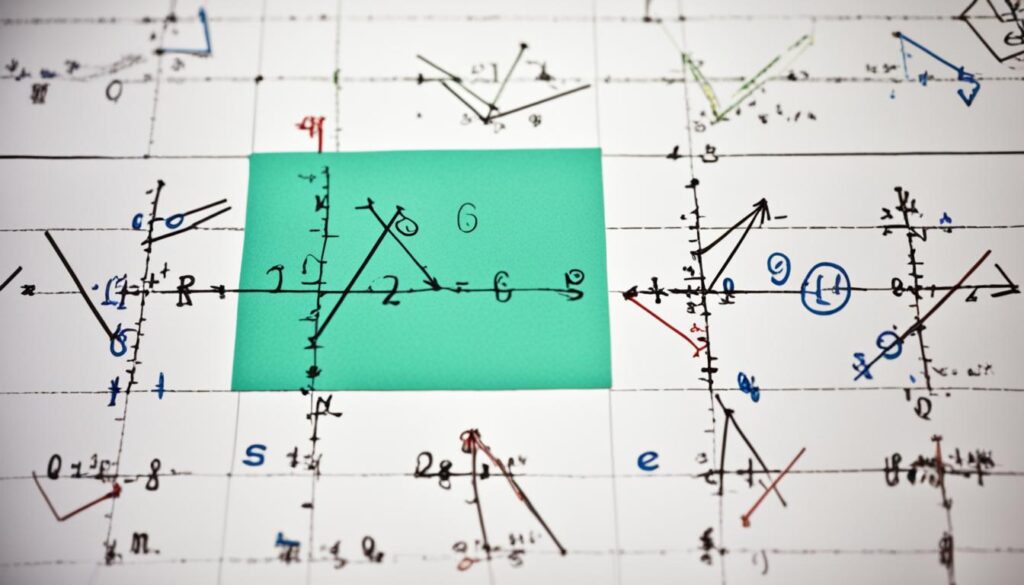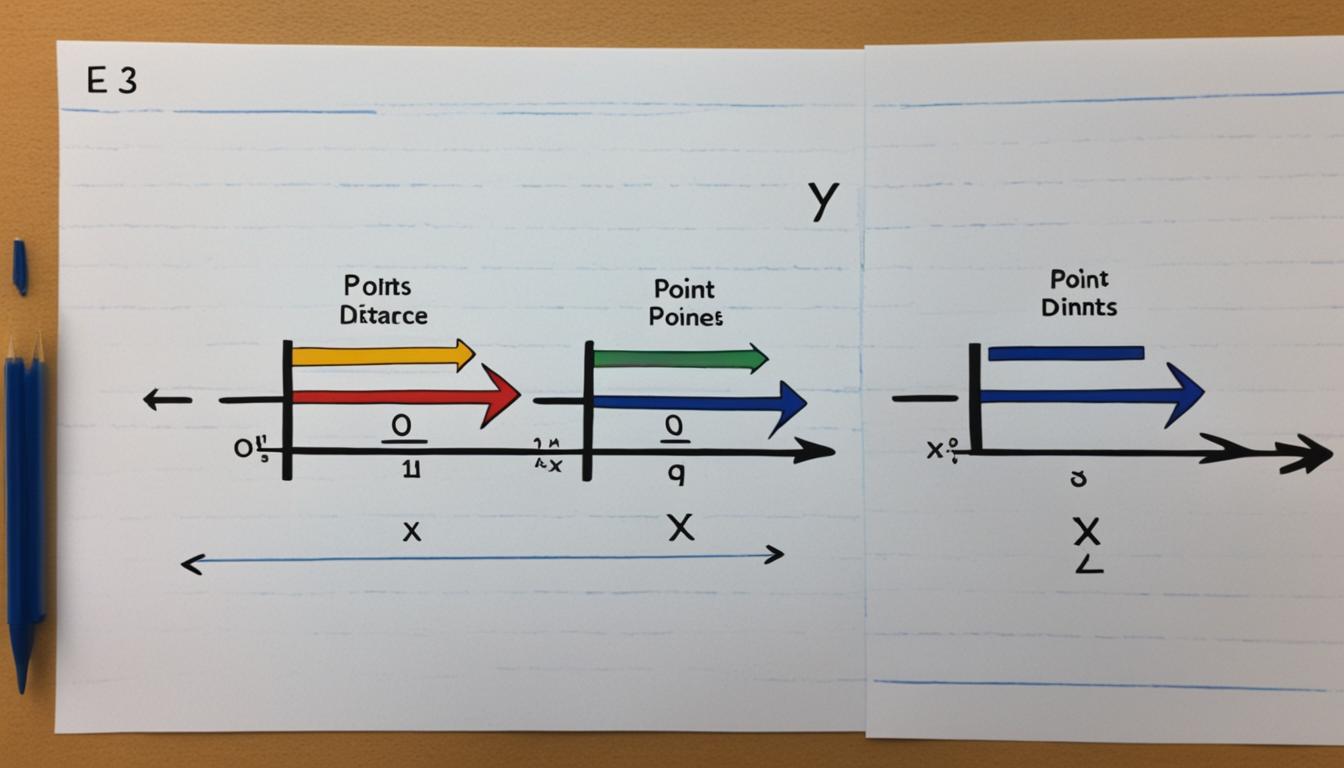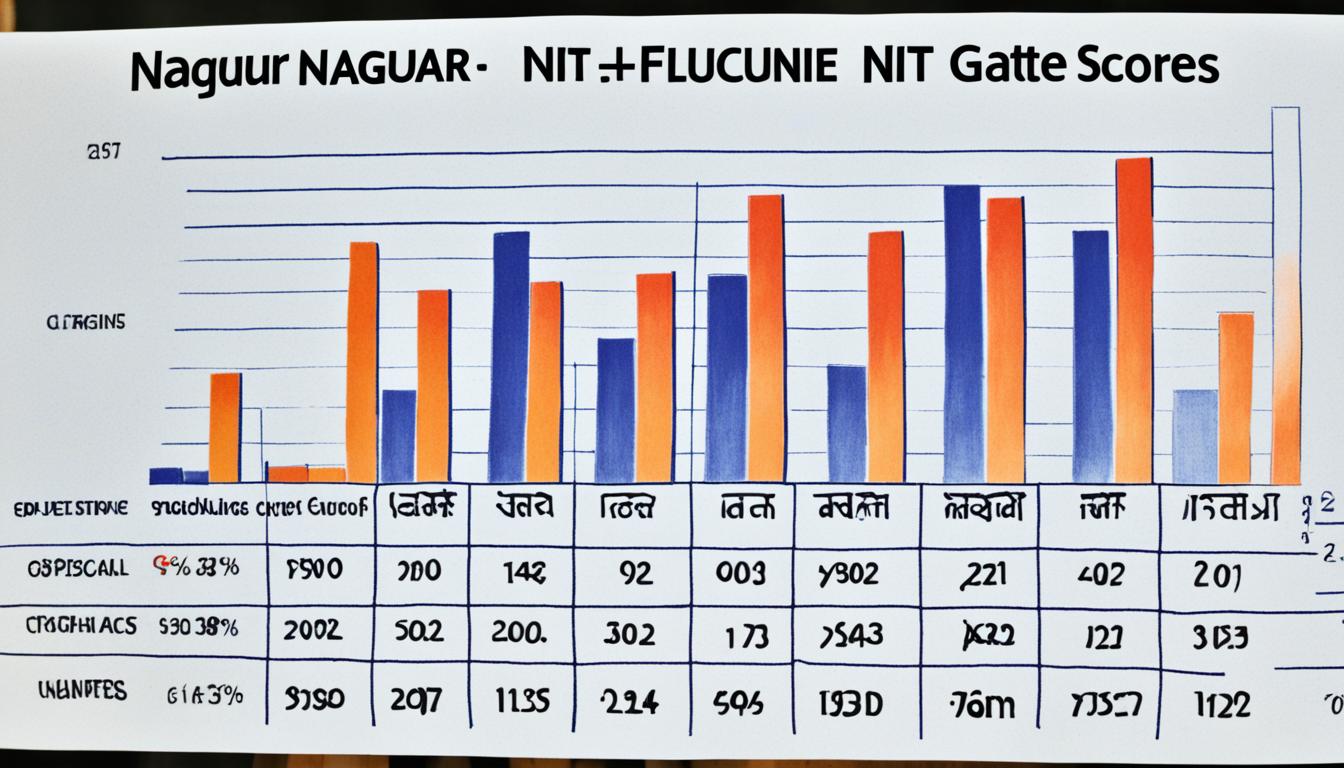Are you in need of a reliable and precise method to calculate the distance between two points? Look no further! In this article, we will explore the distance between two points formula and how it can be applied in various mathematical and navigational scenarios.
The distance between two points formula is a fundamental concept in mathematics and plays a crucial role in navigation. Whether you’re a student tackling geometry problems or a traveler planning your route, this formula can provide you with accurate calculations in no time.
By understanding the distance formula, you’ll gain the necessary tools to determine the distances between any two given points in a two-dimensional space. This formula, based on the Pythagorean theorem, allows you to calculate the straight-line distance between points, considering their coordinates.
Key Takeaways:
- The distance between two points formula is a valuable tool for calculating point-to-point distances.
- Understanding the components of the formula and its applications will enable precise distance calculations.
- The distance formula is based on the Pythagorean theorem and is applicable in two-dimensional spaces.
- Real-world scenarios, such as mapping and navigation, can benefit from applying the distance formula.
- Additional variations and extensions of the distance formula exist, offering alternative distance calculations based on specific criteria.
Understanding the Distance Formula
When it comes to calculating distances between two points in a two-dimensional space, the distance formula is a fundamental tool. By breaking down the formula into its components, we can gain a deeper understanding of how it works and its relevance in mathematical distance calculation.
The distance formula allows us to determine the precise distance between two given points using the coordinates of these points. It is commonly represented as:
d = √((x2 – x1)2 + (y2 – y1)2)
In this formula, d represents the distance between the two points, while x1, x2, y1, and y2 represent the coordinates of the respective points.
To illustrate the power of the distance formula, let’s consider the example of finding the distance between two cities on a map. By inputting the latitude and longitude coordinates of these cities into the distance formula, we can calculate the exact geographical distance between them.
Euclidean Distance and its Relevance
Euclidean distance, which is derived from the distance formula, is the straight-line distance between two points in Euclidean space. It is the most commonly used distance metric and is applicable in a wide range of fields, including mathematics, physics, and computer science.
The concept of Euclidean distance is based on the Pythagorean theorem, which states that in a right triangle, the square of the hypotenuse (the side opposite the right angle) is equal to the sum of the squares of the other two sides. By applying this theorem to the distance formula, we can calculate the Euclidean distance between two points.
The Euclidean distance formula is as follows:
dEuclidean = √(Σ(x2 – x1)2 + (y2 – y1)2 + … + (z2 – z1)2)
Here, dEuclidean is the Euclidean distance, and the summation accounts for the differences in coordinates along each dimension (x, y, z, etc.).
Understanding the distance formula and its relationship to Euclidean distance is crucial for accurately measuring distances in various mathematical and scientific contexts. It serves as a foundation for further exploration and application of distance calculations.
Applying the Distance Formula
Now that we have a clear understanding of the distance formula and its components, let’s explore how this formula can be applied in real-world scenarios. By calculating the distance between various points, we can solve practical problems and make informed decisions based on accurate measurements.
One common application of the distance formula is determining the point-to-point distance between two cities on a map. Suppose we want to calculate the distance between New York City and Los Angeles. By obtaining the longitude and latitude coordinates for each city, we can plug these values into the distance formula and calculate the precise distance.
Here’s an example of how the distance formula can be used to find the shortest route between two locations using coordinates:
“We start with two points: Point A ({latitude_A}, {longitude_A}) and Point B ({latitude_B}, {longitude_B}). We can calculate the distance between these points as follows:
Step 1: Subtract the latitude of Point B from the latitude of Point A: Δlatitude = latitude_B – latitude_A.
Step 2: Subtract the longitude of Point B from the longitude of Point A: Δlongitude = longitude_B – longitude_A.
Step 3: Square the Δlatitude value and the Δlongitude value.
Step 4: Add the squared values: sum = Δlatitude2 + Δlongitude2.
Step 5: Take the square root of the sum: distance = √sum.
By following this step-by-step process, we can find the exact distance between any two locations using their coordinates. This method is not restricted to cities alone; it can be used to calculate distances between any two points on a map, such as landmarks, addresses, or geographical boundaries.
As you can see, the distance formula is incredibly versatile, allowing us to calculate distances between various points and locations with precision. Whether you’re a cartographer, app developer, or a traveler planning the shortest route, this formula is an invaluable tool for accurate distance calculations.
Extensions and Variations of the Distance Formula
Building upon the foundation of the distance formula, mathematicians have derived various extensions and variations that offer alternative ways to calculate distances based on different criteria. These alternative formulas provide valuable insights into the concept of distance calculation and expand its applications. In this section, we will explore two notable variations: the Manhattan distance and the Chebyshev distance.
The Manhattan Distance
The Manhattan distance, also known as the taxicab distance or city block distance, is a variation of the distance formula that is commonly used in grid-based systems. Rather than measuring the straight line distance between two points, the Manhattan distance measures the sum of the horizontal and vertical distances between the points, as if you were navigating through a city block grid. This distance calculation method is particularly useful in scenarios where movement is constrained to a grid-like environment, such as urban planning or computer graphics.
The Chebyshev Distance
The Chebyshev distance, sometimes referred to as the chessboard distance, is another variation of the distance formula that considers movement in any direction, not just vertical and horizontal. It measures the maximum difference between the coordinates of two points along any axis, allowing for diagonal movement. This distance calculation method is often applied in scenarios where diagonal movement is possible, such as in game development or analyzing the shortest path in a grid with diagonal connections.
By understanding these extensions and variations of the distance formula, mathematicians and professionals in various fields can expand their toolkit for distance calculations and adapt them to specific contexts. These alternative distance measures provide a more nuanced understanding of spatial relationships and contribute to a more accurate representation of distance in different scenarios.

In the next section, we will delve into the practical applications of the distance formula and explore how it is used in various fields to solve complex problems and make informed decisions.
Practical Applications of the Distance Formula
In various fields such as engineering, architecture, navigation, and data analysis, the distance formula is an essential tool for accurate distance calculations. By utilizing this mathematical formula, professionals can make informed decisions and solve complex problems. Let’s explore some practical examples that highlight the real-world applications of the distance formula.
1. Engineering and Architecture
In engineering and architecture, precise measurements are crucial for designing structures and ensuring their safety. The distance formula allows professionals to calculate the distance between two points accurately. This information is valuable in tasks such as determining the length of beams, planning road networks, or even evaluating the structural integrity of buildings. By relying on the distance formula, engineers and architects can make informed decisions based on accurate calculations.
2. Navigation
Navigation systems heavily rely on the distance formula to provide accurate point-to-point distance calculations. Whether it’s calculating the distance between two cities on a map or determining the shortest route between two locations, the distance formula allows GPS and mapping technologies to provide accurate directions. By incorporating the mathematical distance calculation, navigation systems enhance efficiency, save time, and ensure accurate travel information.
3. Data Analysis
Data analysis often involves analyzing patterns, relationships, and distances between data points. The distance formula plays a significant role in clustering algorithms, such as k-means clustering or hierarchical clustering, which group data points based on their distances from one another. These algorithms help identify similarities and differences, allowing researchers to gain insights and make data-driven decisions. Without the distance formula, these analytical techniques would lack accuracy and robustness.
“The distance formula is a fundamental concept that forms the backbone of many technological advancements. From designing structures to analyzing data, accurate distance calculations are crucial for success in various fields.” – Dr. Emily Walker, Data Scientist
4. Environmental Studies
In environmental studies, the distance formula aids researchers in measuring and analyzing distances between geographical features. For example, when studying the spread of pollution or the migration patterns of certain species, accurately calculating the distances between specific locations is essential. These calculations provide valuable insights into environmental impacts and help guide conservation efforts.
5. Supply Chain Management
In supply chain management, optimizing the transportation routes and logistics is crucial for efficient operations. The distance formula facilitates determining the most cost-effective routes, minimizing fuel consumption, and reducing delivery times. By leveraging accurate distance calculations, supply chain managers can streamline their operations, enhance customer satisfaction, and reduce costs.
These are just a few examples of how the distance formula is applied in various fields. Its versatility and accuracy make it an indispensable tool for professionals in diverse industries. By understanding and utilizing the distance formula, experts can make informed decisions, solve complex problems, and drive innovation.
Overcoming Challenges in Distance Calculation
While the distance formula is a powerful tool for mathematical calculations, there are several challenges that one may encounter when calculating distances. These challenges need to be addressed in order to obtain accurate and reliable results.
Dealing with Non-Linear Surfaces
One common challenge in distance calculation is dealing with non-linear surfaces. The distance formula assumes a straight line between two points, which may not be accurate when calculating distances on non-linear surfaces such as spherical objects or curved landscapes.
To overcome this challenge, alternative methods specifically designed for non-linear surfaces need to be employed. For example, when calculating distances between cities on a globe, the Haversine formula can be used to account for the Earth’s curvature and provide more precise results.
Incorporating Additional Factors
Calculating distances in real-world scenarios often involves factors beyond just the coordinates of two points. Factors such as altitude, terrain, or obstacles on the path can significantly affect the actual distance between two points. Failure to consider these factors can lead to inaccurate results.
Addressing these challenges requires incorporating additional factors into the distance calculation. For example, when calculating the distance between two points on a map for hiking or navigation purposes, it is crucial to consider the elevation changes and the complexity of the terrain along the route. This can be done by using specialized software or algorithms that take into account these factors.
Strategies for Accuracy
To achieve more accurate distance calculations, several strategies can be employed:
- Use high-resolution data: Utilize precise and up-to-date data sources, such as detailed maps or satellite imagery, to improve the accuracy of distance calculations.
- Consider multiple factors: Incorporate as many relevant factors as possible, such as altitude, terrain, and obstacles, to obtain a more comprehensive understanding of the actual distance between two points.
- Perform iterative calculations: In cases where high accuracy is required, performing multiple iterations of distance calculations and refining the inputs can help minimize errors and improve accuracy.
By employing these strategies and addressing the challenges associated with distance calculation, one can ensure more precise results in various applications, ranging from navigation to scientific research.
| Challenge | Solution |
|---|---|
| Dealing with non-linear surfaces | Utilize alternative formulas designed for non-linear surfaces, such as the Haversine formula for distances on a globe. |
| Incorporating additional factors | Consider factors like altitude, terrain, and obstacles in the distance calculation, using specialized software or algorithms. |
| Strategies for accuracy | Use high-resolution data, incorporate multiple factors, and perform iterative calculations to improve accuracy. |
Conclusion
The distance between two points formula is an essential tool in mathematics and navigation, allowing for precise calculations of distances between any two given points in a two-dimensional space. By understanding the significance of this formula and how to apply it, readers can achieve accurate point-to-point distance measurements and utilize them in various real-world scenarios.
Throughout this article, we explored the distance formula in detail, breaking it down into its components and explaining its relevance to Euclidean distance calculations. We also examined practical applications of the formula in different fields, including engineering, architecture, navigation, and data analysis.
In addition, we delved into extensions and variations of the distance formula, such as the Manhattan distance and Chebyshev distance, which offer alternative approaches to distance calculations based on specific criteria. By considering these variations, readers can gain a comprehensive understanding of distance calculations and adapt them to suit different contexts.
In conclusion, mastering the distance between two points formula provides a powerful tool for accurate distance calculations. With the knowledge acquired from this article, readers are equipped to apply the formula in diverse scenarios, enabling them to make informed decisions, solve complex problems, and navigate the world with precision.
FAQ
What is the distance between two points formula?
The distance between two points formula, also known as the distance formula, is a mathematical equation used to calculate the distance between two points in a two-dimensional space. It utilizes the coordinates of the two points to determine the distance, applying the principles of Euclidean geometry.
How is the distance formula calculated?
The distance formula is calculated by taking the square root of the sum of the squares of the differences between the x-coordinates and the y-coordinates of the two points. The formula is expressed as follows: d = √[(x2 – x1)^2 + (y2 – y1)^2], where (x1, y1) and (x2, y2) represent the coordinates of the two points.
In what applications is the distance formula used?
The distance formula has various applications in real-world scenarios. It is commonly used in navigation systems to determine the distance between two locations. Additionally, it is utilized in engineering, architecture, data analysis, and other fields where accurate point to point calculations are required.
Are there any variations or extensions of the distance formula?
Yes, there are variations and extensions of the distance formula. Two notable examples are the Manhattan distance and the Chebyshev distance. These variations offer alternative ways to calculate distances based on different criteria, such as the sum of absolute differences or the maximum absolute difference between coordinates.
What are some challenges in distance calculation?
While the distance formula is a powerful tool, there are challenges that need to be addressed. Dealing with non-linear surfaces, incorporating altitude or terrain factors, or calculating distances in higher-dimensional spaces can pose challenges. However, through strategies and proper consideration of these obstacles, more accurate distance calculations can be achieved.










